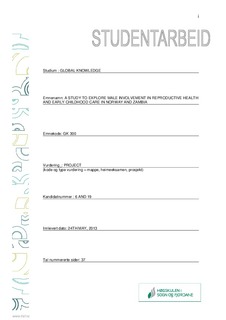| dc.description.abstract | The impact of male involvement in reproductive health and early childhood care in European countries including Norway has shown to yield great benefits for both the mother and child and the man himself. It has demonstrated significant potential in encouraging men’s positive roles in building gender equality and improving men’s and women’s health. However, this is a new concept for most African countries including Zambia where the culture of differences in gender and gender roles is promoted. This has drastically affected the lives of children, women and including men. Involving men in reproductive and early childhood care is one of the strategies that Zambia is using to attain the MDGs 3, 4, and 5 which are; gender equality, promotion of maternal health and reduction of infant mortality.
The purpose of the study was to explore male involvement in reproductive health and early childhood care in Norway and Zambia. A qualitative study design that was explorative, descriptive and contextual was used to purposively select nurses working at the health institution, men who are fathers and the grandfather in Sogndal. The sample consisted of 12 informants; three nurses providing reproductive health services in Sogndal, 5 men from Norway including a grandfather and 4 men from Zambia who were studying in Norway. The sample size was determined by saturation. Data were collected using a semi-structured interview schedule and analysed using content analysis.
The findings of our study showed that men in Norway are very involved in reproductive health and early childhood care while the informants from Zambia also reported having participated in reproductive health and early childhood care. However, this is not typical of the Zambian men as this is done by a few men who have the information and know the benefits of gender equality. Findings of this study also showed that Norway is a high modern society which promotes gender equality while Zambia is a traditional society where there is inequality between men and women. The results of this study further showed that both Norwegian and Zambian men were proud of their participation in reproductive health and early childhood care as it made them to be responsible fathers as well as strengthened the relationship with their partner and baby. However, one of the challenges experienced by both Norwegian and Zambian men in their participation in reproductive health and early childhood care was to make adjustments to their work/school program in order to help their partners take care of the baby. This was more pronounced by the grandfather who participated despite the practice not having been common during his time.
v
Parental leave was cited to be one of the best aspects in promoting male involvement in reproductive health and early childhood care as it provides enough time for fathers to stay home and take care of their partner and baby. However, most of the Norwegian informants did not take their parental leave while none of the Zambian informants took their paternal leave.
In light of our findings, our recommendation to the Norwegian government is to consider carrying out a study on male involvement in reproductive health and early childhood cares were interviews will be conducted on women. While to the Zambian health care system, they should consider funding sensitization programmes to disseminate information to the general public on the benefits of involving men in reproductive health services and early childhood care among others. | no_NO |
